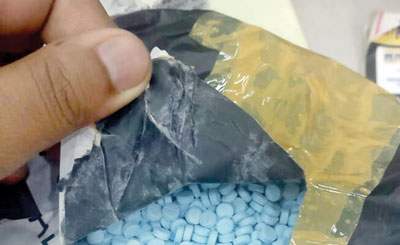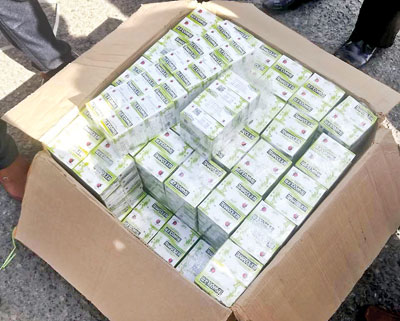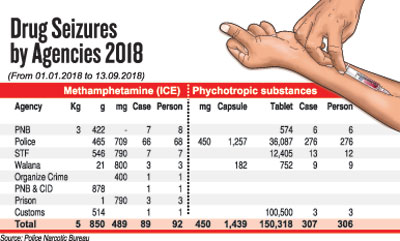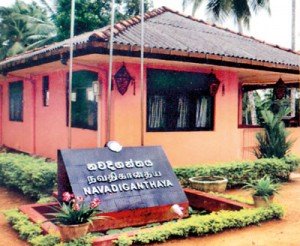News
Drug addiction at school level: It all starts with a small pill
Expert stresses the need for trained counsellors in schools to identify at-risk students early and save them from becoming prey to drug predators
Drug sellers, including wayside pharmacies, adopt various ruses to trap teenage students in psychotropic drug addiction; social media devices also used
He had been experimenting with prescription medicines since he was only 13. He admitted to having abused a range of such drugs, including Artane, Diazepam, Morphine and Restoril. Two other drugs which he referred to by their street names, “Nilla Soya” (Trifluoperazine) and “Apple” (Tramadol), were also popular among young people, he added.
Obtaining the drugs was also not difficult, he claimed. “There was a doctor we knew. His people would call and let us know when the stocks came in,” Rashid revealed, adding that this particular doctor, who runs a practice advertising treatments for heroin addiction, also runs a lucrative side business of selling what are known as psychotropic drugs to heroin addicts. Psychotropic drugs are those capable of affecting the mind, emotions and behaviour. Rashid and five of his friends had even experimented with their own concoction of psychotropic drugs by mixing several tablets together and using them along with heroin. One of his friends subsequently overdosed.
Rashid’s history of abusing psychotropic drugs is increasingly common among young people who become addicted to heroin, officials told the Sunday Times. The drugs being abused are mostly psychiatric medications and painkillers. Those who agreed to speak to the Sunday Times said they experienced strong feelings of euphoria when abusing psychotropic drugs. Some took such drugs believing it gave them more energy to have fun or study.
A consultant psychiatrist, however, noted that the drugs, unless prescribed in controlled doses for specific illnesses, were highly addictive, and could inevitably end up leading users to heroin.
There is now serious concern that many children are experimenting with such drugs while still in school and end up becoming addicted to heroin in their search for a stronger “high.”
Dayan* (22) from Kirindiwela was introduced to psychotropic substances through a classmate in school. “I saw him using Tramadol and was curious. I asked him to give me some, too. I hated it at first, but then tried it again. My inhibitions left me the more I used the drugs. I thought it made it possible to work harder,” he explained. He had initially started with one to two tablets, but had soon become so addicted that he took an entire card of pills at a time. Dayan had got the drugs through his schoolmate. “I paid him Rs 1,000 for two Tramadol cards at a time; one for me and one for him. I don’t know whom he bought the cards from.” Dayan was also soon using Diazepam. “I had no recollection of time and space when I was using the pills,” he said. Being a schoolboy, he was also increasingly asking for money from his parents on various pretexts to finance his habit, which eventually led to his addiction being exposed.
Rakitha* (24), also from Kirindiwela, had also been addicted to drugs from his schooldays. He had first purchased Tramadol through his classmates who were already using it. “It started with a few tablets, but I was soon using more and more. Then, I got addicted to heroin.” Rakitha’s parents had money, so he used what he got from them to finance his habit. He said he would get the tablets from pharmacies known to him.
“What we are increasingly seeing when assessing cases is that most of the younger individuals who are addicted to heroin, had started off by abusing prescription drugs,” revealed Shanika Madubashini, Assistant Counsellor at the “Navadiganthaya” Prevention, Treatment and Rehabilitation Centre. The centre, situated in Urapola, Nittambuwa, is one of four run by the National Dangerous Drugs Control Board (NDDCB), and it was here that the Sunday Times spoke to individuals recovering from addiction.

Though pharmacies have been severely warned of the consequences of selling psychotropic drugs over the counters or illegally, many addicts say they obtain their doses through pharmacies.
Ms Madubashini said that children were starting out abusing psychotropic drugs in their teenage years. The age group from 13-15 years is especially vulnerable given that this is a period where they are most impressionable. “Peer pressure is a crucial factor. Many are introduced to such drugs through their friends in school or tuition classes,” she explained.
Family background and residential environment are also contributory factors. For example, both of Rashid’s elder brothers are heavily addicted to heroin. His family had lived in Slave Island initially, and Rashid told us that neighbourhood drug dealers used him to peddle drugs since he was 16, and “tablets” were very easy for him to find. “I did not go looking for drugs. They came to me,” he said. Suresh* (39) from Peliyagoda, said his next-door neighbours had rented out a room for drug addicts to inject heroin. “Drugs were everywhere. It was very easy to get them.” Suresh, who worked as a Naattami in Pettah, said a pharmacy there would sell psychotropic drugs to heroin addicts like him.
Many succumb to curiosity or peer-pressure and try psychotropic drugs, without ever thinking that it would lead them towards narcotics.
Navin* (25) from Kelaniya is married and the father of a young child. He had been using heroin for eight years. “I first started on tablets when I was 13 after seeing a friend from a tuition class using them,” he stressed, elaborating that he used drugs such as Diazepam, Tramadol and Morphine. He had obtained drugs from dealers in Kelaniya and Thotalanga.
He would spend as much as Rs 5000 on a single occasion to purchase the pills he was addicted to. He would subsequently go on to use ganja and while visiting a dealer to purchase the drug, he met a woman in a nearby house who was dealing in heroin. “She asked me to tell my friends that heroin was available there if we were interested. I saw that her husband was using heroin at the time and was curious to try it. That was that first time I used heroin.” He had gone from using tablets to ganja and then on to heroin; all while still in school.
A recent research by the NDDCB on “Trends and Patterns of Psychotropic Substance Abuse” notes that as the price of heroin rises and supplies become scarce, there is an increasing trend among heroin addicts to turn to psychotropic substances. There is also a new and extremely dangerous trend among young people between the ages of 15 and 25 to abuse psychotropic drugs, the research further states. A research conducted between 2016-2017 found that while using heroin and other drugs, addicts were abusing psychotropic drugs at the same time. Meanwhile, the NDDCB’s research also notes that there is evidence to state that those selling such drugs are targeting schoolchildren.
A senior officer at the Police Narcotics Bureau (PNB) agreed with the findings. Unscrupulous agents of some drug companies were targeting schoolchildren, especially those in their teen years in a variety of ways to sell psychotropic drugs, he claimed. “For example, they would sell 250-500 milligram (mg) dosage of certain painkillers while claiming them to be 150mg. Such pills and capsules have been distributed through pharmacies, dispensaries, nightclubs and parties organised through social media,” he revealed. Initially, samples of such drugs are distributed free of charge near schools and tuition classes by agents, and those who become addicted must then pay for further stocks.
While some pharmacies have been busted selling such drugs illegally to schoolchildren and adults, in certain cases, users don’t even meet their dealer face to face. “When purchasing the drugs, payment is made through eZ Cash method. The users are then given a message to go and pick up the drugs they paid for from a certain place,” the officer disclosed.
The police have uncovered various ways in which such drugs are distributed, the officer said. Some dealers conceal grounded up Tramadol inside erasers found on the back ends of pencils. The pencils are then sold to users. Once you bite into the eraser, the Tramadol is released. Small amounts of drugs were also being hidden in hair gel, according to police.
Social media were also being used in distributing psychotropic substances among young people. Police have found targeted advertising on Facebook. Local Whatsapp groups dedicated to such drug use have also sprung up.
Regulating pharmaceutical products in the country falls under the purview of the National Medicines Regulatory Authority (NMRA). Its Chief Executive Officer (CEO) Dr Kamal Jayasinghe acknowledged that the authority was facing a difficult situation with psychotropic substances being increasingly popular among school students and young people.
There were challenges in tracking down such drugs, he explained. For one, they can be easily hidden and because unlike substances such as cigarettes or alcohol, it was difficult to determine if they were using them since they had no smell. Therefore, identifying someone who abused such drugs was not easy. The authority, meanwhile, has also found that some pharmacies were selling high doses of psychotropic drugs under false labels which claimed the doses were far lower. Such tactics are clearly used to carry out illicit trade, he stressed.
“We have already raided several pharmacies in Colombo where such drugs were being sold illegally. Legal proceedings against the owners of these pharmacies are ongoing and we haven’t allowed those pharmacies to reopen,” Dr Jayasinghe stated. He added that the authority had already held meetings with pharmacy owners island-wide to highlight the harm some unscrupulous pharmacy owners caused to the youths. A special meeting for pharmacy owners in Colombo was convened recently after the raids in the city. Pharmacies were warned that anyone found to be illegally selling psychotropic drugs will be severely dealt with, he emphasised.
He, too, said the NMRA was receiving more complaints that the drugs were being sold near schools and in locations frequented by school students. In certain areas, teachers have raised concerns, reporting that groups of students in their classes seemed to be unusually subdued and silent. “They suspect the children are using some substance or substances, but have no idea what they could be.”
The NMRA has now set up teams to conduct raids island-wide to bust pharmacies selling psychotropic drugs over the counter or illegally. Dr Jayasinghe, though, said the Police, PNB, NDDCB and NMRA needed to work far more closely to successfully tackle the threat.
Assistant Counsellor Shanika Madubashini, meanwhile, lamented that a long established habit of teachers ignoring students who failed to pay attention in class, was hampering efforts to identify the at-risk students . The reason why the students aren’t paying attention or are missing from class maybe because they are in the early stages of abusing psychotropic drugs, she pointed out. She stressed that it was essential for authorities to look into the possibility of having trained counsellors in schools to identify at-risk students and prevent them from falling prey to drug abuse.
* Names have been changed to protect individuals’ privacy
| Bringing out the good in them | |
Society has a very low opinion of those deemed as “drug addicts,” with all of them being painted with the same brush. “Most people say they are just thieves, but the truth is that a vast majority are far from that. Their addiction may push some towards doing desperate things, but there is enormous potential for good in so many of them,” insisted Chamikara Jayasinghe, Manager of the “Navadiganthaya,” Prevention, Treatment and Rehabilitation Centre. The centre provides in-house treatment to individuals over 21 years of age, who have been using drugs for six years or less. The centre, one of four run by the National Dangerous Drugs Control Board (NDDCB), takes in voluntary admissions as well as cases referred through courts. All those being treated are primarily addicted to heroin.  Navadiganthaya centre: Open for voluntary admission The centre has the capacity to house 60 inmates and there are 18 treatment staff. Mr Jayasinghe noted that many of those who come in for treatment do so voluntarily, out of a real desire to quit their addiction. The treatment period is two months and is done free of charge. For those who cannot wait that long, there is a paying ward for a course that lasts 14 days. Mr Jayasinghe, however, said they encourage people to admit themselves for the two month treatment programme as it gives staff far more time and space to comprehensively deal with the problem. Once they complete the two month course, they are encouraged to come for followup meetings on the third Sunday of each month. Mr Jayasinghe, however, acknowledged that only about 25-30 percent of those who complete the course turn up for the followup meetings, with about 70 percent relapsing. “The good thing, however, is that from the reports we have got, even many of those who relapse aren’t as disruptive as before, and some actually return for fresh treatment,” he said. Every addictive drug conditions the brain that nothing can be done without it, Mr Jayasinghe observed, adding that they try their best to convince those who come to the centre that their withdrawal symptoms won’t be as bad as they fear. “No one dies from not having heroin. Once they spend some time without the drugs and get used to being without them, they tend to understand that their fears were unfounded.” The men here, many in their 20s, desperately want to kick their addiction, and are well aware of the pain and suffering it has caused, both to themselves and to their families. Dayan* (22), who became addicted to psychotropic drugs in school, was an extremely bright student, and was studying in the mathematics stream for his Advanced Level exam when his addiction ruined his education. Yet, he is determined to conquer his demons and get his life back on track. He plans to follow a technical study course and go abroad. Navin* (25), wants to find a job again and be a father his young child can be proud of. Suresh* (39), whose heroin addiction led his wife to leave him and move out with their two children, wants nothing more than to finally end his addiction and to be a father to the children again. NDDCB runs four rehab centres The NDDCB has four Prevention, Treatment and Rehabilitation Centres located at Peradeniya, Talangama, Unawatuna and Nittambuwa. All the centres are open for voluntary admissions. Officials, however, caution that space is limited and for people to call beforehand and schedule an appointment with the respective centre. Central Province Prevention, Treatment and Rehabilitation Centre (For those below 21 years)
Address – Mahenawatta, Urapola, Nittambuwa (Tel: 033 – 2283060) |

